Parikshit Ram
Modern Methods in Associative Memory
Jul 08, 2025Abstract:Associative Memories like the famous Hopfield Networks are elegant models for describing fully recurrent neural networks whose fundamental job is to store and retrieve information. In the past few years they experienced a surge of interest due to novel theoretical results pertaining to their information storage capabilities, and their relationship with SOTA AI architectures, such as Transformers and Diffusion Models. These connections open up possibilities for interpreting the computation of traditional AI networks through the theoretical lens of Associative Memories. Additionally, novel Lagrangian formulations of these networks make it possible to design powerful distributed models that learn useful representations and inform the design of novel architectures. This tutorial provides an approachable introduction to Associative Memories, emphasizing the modern language and methods used in this area of research, with practical hands-on mathematical derivations and coding notebooks.
Finding Clustering Algorithms in the Transformer Architecture
Jun 23, 2025Abstract:The invention of the transformer architecture has revolutionized Artificial Intelligence (AI), yielding unprecedented success in areas such as natural language processing, computer vision, and multimodal reasoning. Despite these advances, it is unclear whether transformers are able to learn and implement precise algorithms. Here, we demonstrate that transformers can exactly implement a fundamental and widely used algorithm for $k$-means clustering: Lloyd's algorithm. First, we theoretically prove the existence of such a transformer architecture, which we term the $k$-means transformer, that exactly implements Lloyd's algorithm for $k$-means clustering using the standard ingredients of modern transformers: attention and residual connections. Next, we numerically implement this transformer and demonstrate in experiments the exact correspondence between our architecture and Lloyd's algorithm, providing a fully neural implementation of $k$-means clustering. Finally, we demonstrate that interpretable alterations (e.g., incorporating layer normalizations or multilayer perceptrons) to this architecture yields diverse and novel variants of clustering algorithms, such as soft $k$-means, spherical $k$-means, trimmed $k$-means, and more. Collectively, our findings demonstrate how transformer mechanisms can precisely map onto algorithmic procedures, offering a clear and interpretable perspective on implementing precise algorithms in transformers.
Transformers Learn Faster with Semantic Focus
Jun 18, 2025Abstract:Various forms of sparse attention have been explored to mitigate the quadratic computational and memory cost of the attention mechanism in transformers. We study sparse transformers not through a lens of efficiency but rather in terms of learnability and generalization. Empirically studying a range of attention mechanisms, we find that input-dependent sparse attention models appear to converge faster and generalize better than standard attention models, while input-agnostic sparse attention models show no such benefits -- a phenomenon that is robust across architectural and optimization hyperparameter choices. This can be interpreted as demonstrating that concentrating a model's "semantic focus" with respect to the tokens currently being considered (in the form of input-dependent sparse attention) accelerates learning. We develop a theoretical characterization of the conditions that explain this behavior. We establish a connection between the stability of the standard softmax and the loss function's Lipschitz properties, then show how sparsity affects the stability of the softmax and the subsequent convergence and generalization guarantees resulting from the attention mechanism. This allows us to theoretically establish that input-agnostic sparse attention does not provide any benefits. We also characterize conditions when semantic focus (input-dependent sparse attention) can provide improved guarantees, and we validate that these conditions are in fact met in our empirical evaluations.
Reasoning Model Unlearning: Forgetting Traces, Not Just Answers, While Preserving Reasoning Skills
Jun 15, 2025Abstract:Recent advances in large reasoning models (LRMs) have enabled strong chain-of-thought (CoT) generation through test-time computation. While these multi-step reasoning capabilities represent a major milestone in language model performance, they also introduce new safety risks. In this work, we present the first systematic study to revisit the problem of machine unlearning in the context of LRMs. Machine unlearning refers to the process of removing the influence of sensitive, harmful, or undesired data or knowledge from a trained model without full retraining. We show that conventional unlearning algorithms, originally designed for non-reasoning models, are inadequate for LRMs. In particular, even when final answers are successfully erased, sensitive information often persists within the intermediate reasoning steps, i.e., CoT trajectories. To address this challenge, we extend conventional unlearning and propose Reasoning-aware Representation Misdirection for Unlearning ($R^2MU$), a novel method that effectively suppresses sensitive reasoning traces and prevents the generation of associated final answers, while preserving the model's reasoning ability. Our experiments demonstrate that $R^2MU$ significantly reduces sensitive information leakage within reasoning traces and achieves strong performance across both safety and reasoning benchmarks, evaluated on state-of-the-art models such as DeepSeek-R1-Distill-LLaMA-8B and DeepSeek-R1-Distill-Qwen-14B.
Dense Associative Memory with Epanechnikov Energy
Jun 12, 2025Abstract:We propose a novel energy function for Dense Associative Memory (DenseAM) networks, the log-sum-ReLU (LSR), inspired by optimal kernel density estimation. Unlike the common log-sum-exponential (LSE) function, LSR is based on the Epanechnikov kernel and enables exact memory retrieval with exponential capacity without requiring exponential separation functions. Moreover, it introduces abundant additional \emph{emergent} local minima while preserving perfect pattern recovery -- a characteristic previously unseen in DenseAM literature. Empirical results show that LSR energy has significantly more local minima (memories) that have comparable log-likelihood to LSE-based models. Analysis of LSR's emergent memories on image datasets reveals a degree of creativity and novelty, hinting at this method's potential for both large-scale memory storage and generative tasks.
On Learning Representations for Tabular Data Distillation
Jan 23, 2025Abstract:Dataset distillation generates a small set of information-rich instances from a large dataset, resulting in reduced storage requirements, privacy or copyright risks, and computational costs for downstream modeling, though much of the research has focused on the image data modality. We study tabular data distillation, which brings in novel challenges such as the inherent feature heterogeneity and the common use of non-differentiable learning models (such as decision tree ensembles and nearest-neighbor predictors). To mitigate these challenges, we present $\texttt{TDColER}$, a tabular data distillation framework via column embeddings-based representation learning. To evaluate this framework, we also present a tabular data distillation benchmark, ${{\sf \small TDBench}}$. Based on an elaborate evaluation on ${{\sf \small TDBench}}$, resulting in 226,890 distilled datasets and 548,880 models trained on them, we demonstrate that $\texttt{TDColER}$ is able to boost the distilled data quality of off-the-shelf distillation schemes by 0.5-143% across 7 different tabular learning models.
Quantifying artificial intelligence through algebraic generalization
Nov 08, 2024Abstract:The rapid development of modern artificial intelligence (AI) systems has created an urgent need for their scientific quantification. While their fluency across a variety of domains is impressive, modern AI systems fall short on tests requiring symbolic processing and abstraction - a glaring limitation given the necessity for interpretable and reliable technology. Despite a surge of reasoning benchmarks emerging from the academic community, no comprehensive and theoretically-motivated framework exists to quantify reasoning (and more generally, symbolic ability) in AI systems. Here, we adopt a framework from computational complexity theory to explicitly quantify symbolic generalization: algebraic circuit complexity. Many symbolic reasoning problems can be recast as algebraic expressions. Thus, algebraic circuit complexity theory - the study of algebraic expressions as circuit models (i.e., directed acyclic graphs) - is a natural framework to study the complexity of symbolic computation. The tools of algebraic circuit complexity enable the study of generalization by defining benchmarks in terms of their complexity-theoretic properties (i.e., the difficulty of a problem). Moreover, algebraic circuits are generic mathematical objects; for a given algebraic circuit, an arbitrarily large number of samples can be generated for a specific circuit, making it an optimal testbed for the data-hungry machine learning algorithms that are used today. Here, we adopt tools from algebraic circuit complexity theory, apply it to formalize a science of symbolic generalization, and address key theoretical and empirical challenges for its successful application to AI science and its impact on the broader community.
Dense Associative Memory Through the Lens of Random Features
Oct 31, 2024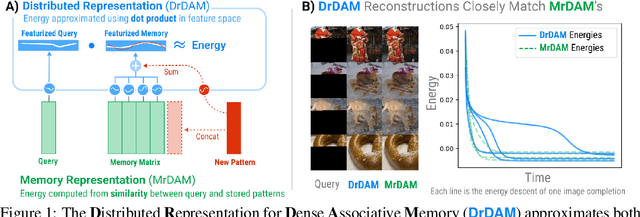

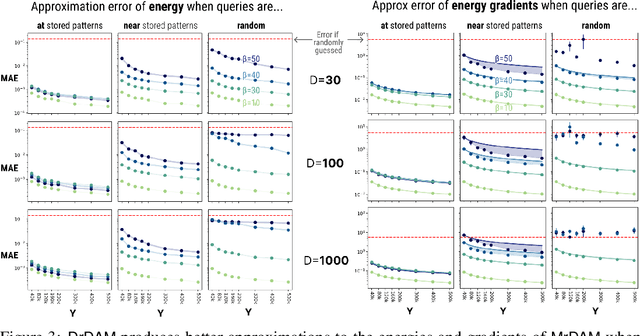
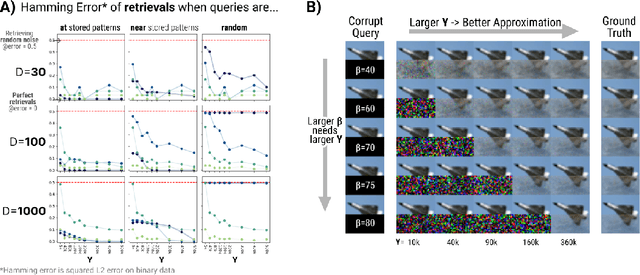
Abstract:Dense Associative Memories are high storage capacity variants of the Hopfield networks that are capable of storing a large number of memory patterns in the weights of the network of a given size. Their common formulations typically require storing each pattern in a separate set of synaptic weights, which leads to the increase of the number of synaptic weights when new patterns are introduced. In this work we propose an alternative formulation of this class of models using random features, commonly used in kernel methods. In this formulation the number of network's parameters remains fixed. At the same time, new memories can be added to the network by modifying existing weights. We show that this novel network closely approximates the energy function and dynamics of conventional Dense Associative Memories and shares their desirable computational properties.
WAGLE: Strategic Weight Attribution for Effective and Modular Unlearning in Large Language Models
Oct 23, 2024Abstract:The need for effective unlearning mechanisms in large language models (LLMs) is increasingly urgent, driven by the necessity to adhere to data regulations and foster ethical generative AI practices. Despite growing interest of LLM unlearning, much of the existing research has focused on varied unlearning method designs to boost effectiveness and efficiency. However, the inherent relationship between model weights and LLM unlearning has not been extensively examined. In this paper, we systematically explore how model weights interact with unlearning processes in LLMs and we design the weight attribution-guided LLM unlearning method, WAGLE, which unveils the interconnections between 'influence' of weights and 'influence' of data to forget and retain in LLM generation. By strategically guiding the LLM unlearning across different types of unlearning methods and tasks, WAGLE can erase the undesired content, while maintaining the performance of the original tasks. We refer to the weight attribution-guided LLM unlearning method as WAGLE, which unveils the interconnections between 'influence' of weights and 'influence' of data to forget and retain in LLM generation. Our extensive experiments show that WAGLE boosts unlearning performance across a range of LLM unlearning methods such as gradient difference and (negative) preference optimization, applications such as fictitious unlearning, malicious use prevention, and copyrighted information removal, and models including Zephyr-7b-beta and Llama2-7b. To the best of our knowledge, our work offers the first principled method for attributing and pinpointing the influential weights in enhancing LLM unlearning. It stands in contrast to previous methods that lack weight attribution and simpler weight attribution techniques.
Mitigating Forgetting in LLM Supervised Fine-Tuning and Preference Learning
Oct 20, 2024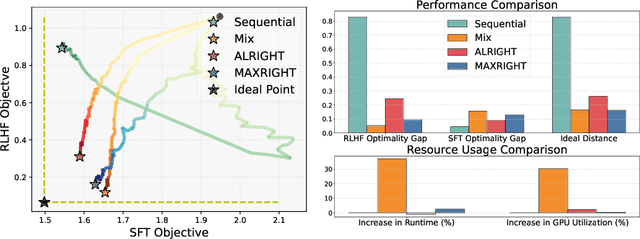

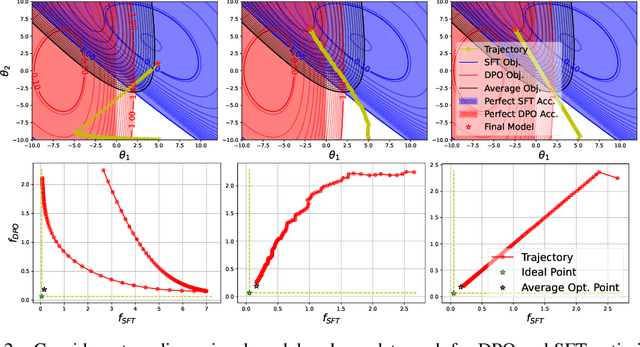
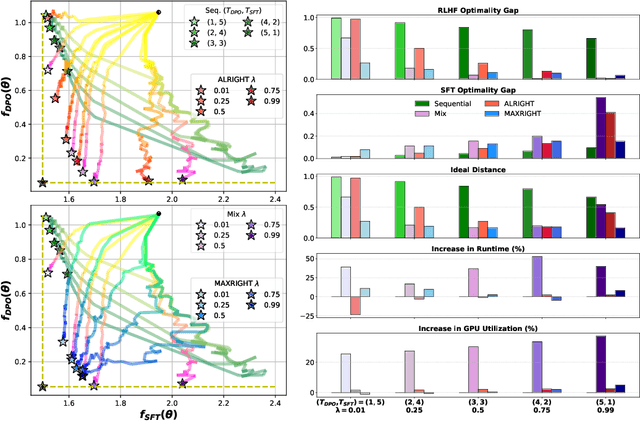
Abstract:Post-training of pre-trained LLMs, which typically consists of the supervised fine-tuning (SFT) stage and the preference learning (RLHF or DPO) stage, is crucial to effective and safe LLM applications. The widely adopted approach in post-training popular open-source LLMs is to sequentially perform SFT and RLHF/DPO. However, sequential training is sub-optimal in terms of SFT and RLHF/DPO trade-off: the LLM gradually forgets about the first stage's training when undergoing the second stage's training. We theoretically prove the sub-optimality of sequential post-training. Furthermore, we propose a practical joint post-training framework with theoretical convergence guarantees and empirically outperforms sequential post-training framework, while having similar computational cost. Our code is available at https://github.com/heshandevaka/XRIGHT.
 Add to Chrome
Add to Chrome Add to Firefox
Add to Firefox Add to Edge
Add to Edge